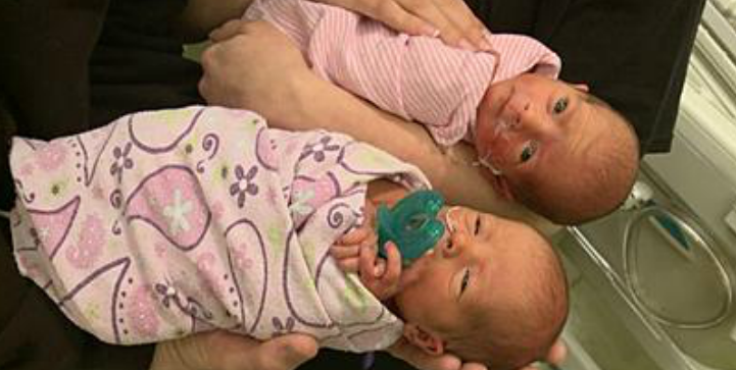Two Of A Kind: Iowa Woman With Stomach Ache Finds Out She's Pregnant, Gives Birth To Rare Mono-Mono Twins

An Iowa woman with severe stomach pains defeated all odds when she walked into a medical clinic and walked out with a life-changing surprise: twins. Shelby Magnani and her fiance James Croskey of Ankeny, Iowa, learned Magnani was six months pregnant with a rare set of twins after being rushed to the emergency room for an ultrasound. She had no idea she was pregnant with one baby, let alone twin girls, let alone monoamniotic, or “mono-mono” twins — a type that occurs in less than one percent of twins.
“'I had really sharp pain in my left side and went into the doctor, and they said, 'We think you might be pregnant.' They told me I was six months and told me to get down to the ER. They did an ultrasound and told me it was twins,” Magnani told WHO-TV. “It`s pretty nuts, still sinking in,” said Croskey, both surprised and excited about the news. The twins, Ava and Anna, will continue to spend the next several weeks in the NICU at Mercy Hospital Medical Center in Des Moines for monitoring.
Magnani’s case is extremely rare as only one to two percent of all pregnancies are twins, but even rarer than that is mono-mono twins. These babies face serious complications, including a 50 percent survival rate. Dr. Jennifer Krupp with Perinatal Center of Iowa told WHO-TV, “They have one placenta and one amniotic sac, and both of those twins share the placenta as well as the sac.”
Some of the serious complications they face include the possibility of entanglement of the cords due to the close proximity of the two umbilical cords in the amniotic sac. Twins can compress one another’s cords, which endangers their oxygen and food supply. The Texas Children’s Hospital says mono-mono twins can also develop twin-to-twin transfusion syndrome (TTTS), where one twin receives the majority of the nourishment in the womb, causing the other twin to become undernourished and sickly. However, since mono-mono twins only have one amniotic sac, TTTS diagnosis is difficult and is therefore contingent on the physical development of both of the twins.
The couple continues to remain positive and are thankful for their “little miracles.” “I`m still trying to process. It`s crazy how high risk mono-mono twins can be and how good they`re doing now. It`s really a blessing. They`re both just little miracles. It could have been so many things that went wrong that didn’t,” Magnani said.
Surprise pregnancies like Magnani’s are becoming more and more common as most cohabiting couples originally intend to delay childbirth until they’re married, steadily employed and financially stable. A study published in the journal Family Relations found surprise pregnancies are common, particularly among working-class men and women who struggle to plan for and access reliable contraceptives. Although about 50 percent of U.S. births are unplanned, cohabitating women are found to be more susceptible to having unintended pregnancies than single or married women.
Magnani and Croskey are still in school at DMACC for automotive technology, Fox CT reported. They hope to open their own business following graduation. The couple admits to loving their two girls more than anything.



























